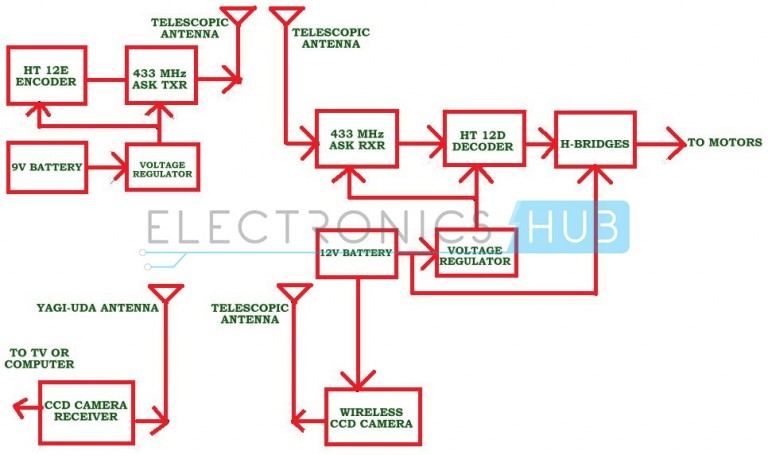Among various tutorials of Electronics Hub, this project aims to make a spy robot that can be sent to the remote areas and is designed to capture audio and video information. The robot can be controlled by the remote, which has four switches to direct it in four directions in a maximum controllable range of 125 meters.
This type of remote Operated Spy Robot Applications can be used to keep a check on the behavior of wild animals where human beings cannot reach, in army applications to detect the bombs, in industries etc. There are some limitations in this project like the system does not work for longer distances and also it is actually a theoretical circuit, hence when it will be implemented practically, it may require some changes.
The CCD camera installed in the robot helps it to sense the environment. The data is sent to the receiver via Radio Frequency wireless communication. HT12E encoder generates 8-bit address and 4-bit data when any key is pressed in remote and simultaneously ASK (Amplitude shift keying) transmitter directs 8-bit address and 4-bit data to the receiver.
DIP (dual inline package) switches of the remote are used to set 8-bit address. After receiving 12-bit data, the receiver gives it to the HT12D decoder to decode the data, which is transferred to the L293D motor driver to rotate the robot motors.
Block Diagram of Remote Operated Spy Robot:

The components required for the circuit are HT12E encoder, HT12D decoder, RF 433 MHz Transmitter and Receiver, L293D motor driver, Wireless CCD camera, push buttons, DC battery, Robot, Resistors, SPST switch and NOT gates – 4. The complete system is divided into two units- remote control section for controlling the robot and video transmission section for transmitting audio and video information.
In the Remote Control Section, HT12E encoder reads the equivalent data from the switches and transfers this data to the RF transmitter serially. In the video Transmission Section, the major components are wireless camera, RF receiver, and Robot.
The Spy Robot is operated by installing the connections as per the circuit diagram and arranging the wireless CCD camera to the robot. The wireless camera receiver gives connection to the computer or TV and with this; both robot and remote supplies are switched on. Hence, the spy robot is controlled using remote, which can be seen on your computer or TV.
For more details, check the link down below.
Filed Under: Reviews


Questions related to this article?
👉Ask and discuss on EDAboard.com and Electro-Tech-Online.com forums.
Tell Us What You Think!!
You must be logged in to post a comment.